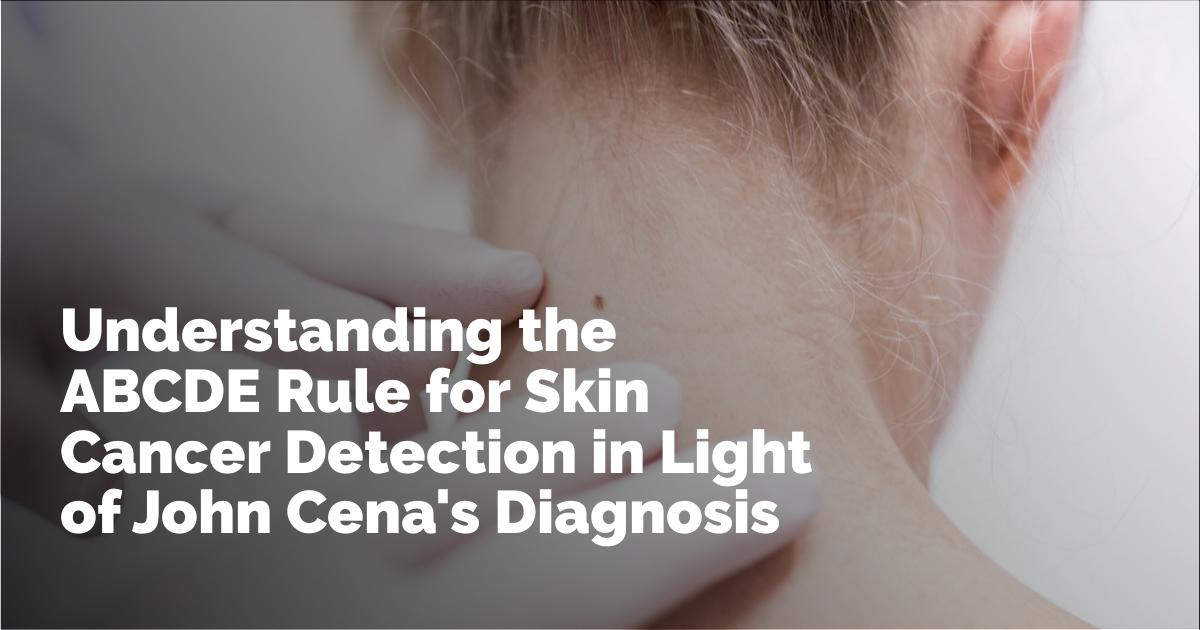The Importance of Skin Cancer Awareness: A Personal Insight from John Cena
With the prevalence of skin cancer continuing to rise, public figures stepping forward to share their own experiences can serve as a powerful reminder of this serious health concern. WWE superstar and actor John Cena recently opened up about his personal battle with skin cancer, aiming to raise awareness and encourage preventive measures against this common yet dangerous disease.
Understanding the ABCDE Rule for Early Detection of Skin Cancer
Skin cancer, like other types of cancer, requires prompt attention and early detection for the best outcomes. One simple and effective method to identify potential signs of melanoma, the most dangerous form of skin cancer, is the ABCDE rule. This guideline can assist individuals in recognizing suspicious moles or skin changes, potentially saving lives through early intervention.
John Cena's Personal Battle with Skin Cancer
John Cena, renowned for his larger-than-life persona, has faced the quiet yet daunting challenge of skin cancer not once, but twice. In his early twenties, a dermatologist discovered and removed cancerous lesions from his right pectoral area, only to find another spot on his right shoulder a year later. Despite the gravity of his diagnosis, Cena admits that, during his youth, he failed to prioritize sun protection, particularly after relocating to the sun-drenched state of Florida from his childhood home in Massachusetts.
Reflecting on his past, Cena confessed to being overly complacent, believing the risk would never affect him. "I also thought the problem would never reach me," he shared, pointing to his extensive sun exposure with minimal protection as a catalyst for his skin cancer diagnoses.
The Reality of Skin Cancer: Common Yet Often Overlooked
Skin cancer is one of the most prevalent types of cancer, especially among those aged 15 to 24. The primary culprit behind melanoma is exposure to ultraviolet light from the sun or artificial sources like tanning beds. The likelihood of developing melanoma increases with certain risk factors, including age, fair skin, numerous moles, and a family history of the disease.
Gaining awareness of the ABCDE rule can help in spotting the early signs of melanoma. Here's a closer look at the components of this crucial guideline:
Asymmetry: A Sign to Watch For
The Asymmetry rule suggests examining moles for any unevenness. If one half of a mole does not match the other half, it should be evaluated by a medical professional. The Skin Cancer Foundation explains that when you draw a line through the middle of a suspicious lesion, the two halves that do not match may indicate something more than a standard mole.
Borders That Raise Concern
The border of a mole is another important feature to assess. Uneven or irregular edges are potential red flags. Unlike the smooth, even borders typical of benign moles, irregular borders could signify a malignant change.
The Importance of Color Uniformity
Color variation within a mole can be a warning sign. While benign moles tend to be a single shade of brown, melanomas may exhibit multiple colors, including varying shades of brown, tan, or black. As the melanoma progresses, colors such as red, white, and blue may also emerge.
Monitoring Mole Diameter
Diameter is another crucial aspect of the ABCDE rule. Moles larger than 6mm, approximately the size of a pencil eraser, require extra vigilance. Some specialists assert that even smaller lesions darker than others demand attention, as rare, colorless amelanotic melanomas can occur.
Evolving Characteristics of Moles
Finally, any changes in a mole's size, shape, color, or texture, or the emergence of symptoms like itching or bleeding, should be promptly evaluated. Monitoring these evolving characteristics adds an extra layer of vigilance against potential melanoma development.
Public Support and Resources for Those Affected by Skin Cancer
For those grappling with skin cancer or fearing its possibility, support systems play a crucial role. Organizations such as Macmillan Cancer Support offer confidential assistance, ensuring individuals can discuss their concerns and seek advice without judgment. Through its support line, available seven days a week, Macmillan provides a vital resource for those touched by cancer.
In conclusion, John Cena's candid revelation shines a spotlight on the importance of skin cancer awareness and proactive measures to protect oneself from harmful UV exposure. Embracing tools like the ABCDE rule can empower individuals to take charge of their skin health, potentially averting the life-altering impact of melanoma.
출처 : Original Source

